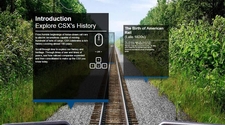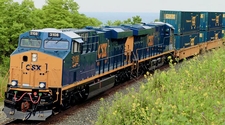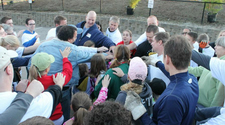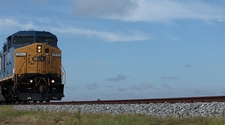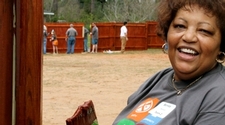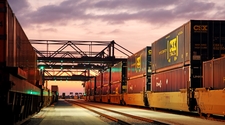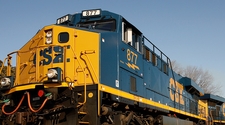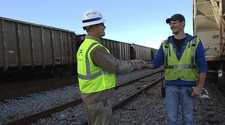| Take Twenty |
The act of stopping for a meal period. |
| Tamper |
A power-driven machine for compacting ballast under ties. |
| Tangent Track |
Straight track. |
| Tank Car |
A car the body of which consists of a tank for carrying liquids such as oil, molasses, vinegar, acids, compressed gasses and granular solids. |
| Tank Dome |
A vertical cylinder attached to the top of a tank car. It permits the tank proper to be filled to full cubical capacity, which would be impossible if there were no allowance for expansion in the dome. |
| Tap Line (Slang) |
A short railroad usually owned or controlled by the industries which it serves and "tapping" (connected with) a truck line. |
| Tare Weight (AKA Light Weight or Tare) |
The weight of an empty railroad car. |
| Tariff |
A publication issued by carriers or their agents, showing rates, fares, charges, classifications, rules, etc. of the carrier. |
| Tariff Publishing Bureau |
An independent agency which publishes transportation rates, rules and provisions at the direction of railroads. |
| Tariff Weights |
Minimum weights specified by a tariff to qualify for a given rate. Differs from actual scale weights, weight agreement weights, and estimated weights. |
| TDCC |
Transportation Data Coordinating Committee which has established EDI (Electronic Data Interchange) standards for the rail industry. |
| TDSI (Total Distribution Services, Inc.) |
The CSXT warehouse storage and distribution service. |
| Team Track |
A track subject to use by the general public, with facilities for loading and unloading cars. (Also known as Public Delivery Track) |
| TECS |
Transportation Employees Calling System. |
| Telemetry Equipment |
Equipment comprised of an End of Train Device (EOT) and Head of Train Device (HTD), used for transmission of information to the controlling locomotive from the rear of a train. End of Train Device (EOT): A portable transmitter unit mounted on the last car of a train which transmits information to the Receiver Display Unit. Head of Train Device (HTD): An appliance in the locomotive cab that receives information from the End of Train Device (EOT) and provides a readout to the engineer. Two-Way End of Train |
| Tender |
The offer of goods for transportation, or the offer to place cars for loading or unloading. |
| Terminal |
A facility owned by a railroad on its line for the handling of freight and for the breaking up, making up, forwarding, and servicing of trains. OR An input/output (I/O) device connected to a computer. OR Point where train and engine employees originate and/or terminate their tour of duty. OR A designated area within a metropolitan area where one or more rail yards exist. |
| Terminal Carrier |
The transportation line making delivery of a shipment at destination. |
| Terminal Charge |
A charge made for services performed at a terminal. |
| Terminal or Belt Line Railroad |
A short line railroad operation within and/or around a city and connecting with one or more larger or trunk line railroads. |
| Terminal Service Center |
Main office for agency and yard employees. Controls functions of major terminals and outlying rail points for a specified geographic area. |
| Terrain Characteristics |
The percent of ascending and descending grades and the degree of curvature over which the train is moving. |
| Test Weight Car |
See Scale Test Car. |
| Thawing Shed |
Heated facility for thawing commodities (frozen during transit) so they may be unloaded (i.e. coal). |
| Third Party |
Neither the shipper nor the consignee, yet the patron who is responsible for payment of freight charges. |
| Third Party Link |
One patron's local address is linked to a different patron's billing address. |
| Third Rail |
An electric conductor located alongside the running rail from which power is collected by means of a sliding contact shoe attached to the truck of electric equipment. |
| Third Rail Shoe |
An insulated metallic sliding contact, mounted on the truck of an electric locomotive for collecting current from an insulated third rail located alongside the running rails. Positive contact between shoe and rail is maintained by gravity, a spring or pneumatic pressure. |
| Three Step Protection |
Additional protection that is provided prior to employees fouling equipment. This procedure will require the locomotive engineer to apply the train brakes, place the reverser in neutral position, and open generator field switch. |
| Threshold/Tier Rates |
A change in the rate charge once a predetermined number of shipments, cars, or weight has been shipped. |
| Throttle Modulation |
Minor adjustments of the throttle for the purpose of controlling tractive effort. |
| Through Amount |
Total freight charges added to shipment after reconsignment. |
| Through Rate |
A rate applicable from point of origin to destination. A through rate may be either a joint rate or a combination of two or more rates. |
| Through Train |
Train operating between principal terminals, usually with few, if any, stops to set out, pickup, or switch cars. |
| TIC |
The Trailer Inventory Control System. Maintains the standing inventory of trailers, containers and flat cars at a ramp location. The inventory is maintained by equipment size, status, ownership and road account. |
| Tie |
Pieces of lumber laid under rails and to which those rails are attached. |
| Tie 'Em Down (Slang) |
Apply hand brakes to cars by tightening maximum amount to keep cars from rolling away. |
| Tie Down |
Any device for securing a load to the deck of a car. |
| Tie On (Slang) |
Couple cars to a train. |
| Tie Plate |
A metal plate providing a bearing surface for the rail on the crosstie. |
| Tie Up (Slang) |
The act of stopping work for meal or rest. |
| Timetable |
A publication containing instructions relating to the movement of trains or equipment and other essential information. |
| TOFC (Trailer on Flat Car) |
Freight loaded in trailers and transported by rail on flat cars. Sometimes called piggyback, pig, or tote. |
| Tolerance |
An allowance made for differences in weight due to variations in scales, weather conditions, or the inherent nature of a commodity. |
| Tool Train (Slang) |
Wreck train used for clearing up derailments. |
| Total Return to Stockholders |
Stock-price change plus reinvested dividends expressed as a percentage of the purchase price of the stock. |
| Tower |
Building of sufficient height erected along the right-of-way to permit maximum viewing. May house Yardmaster, Trainmaster or block operator. |
| Tracer |
A request to trace a shipment for the purpose of expediting its movement or establishing delivery. OR A request for an answer to a communication. |
| Tracing |
Obtaining information concerning a car's location, destination and other billing information. |
| Track |
The space between the rails and space of not less than four feet outside each rail. |
| Track Car |
Equipment, other than trains, operated on track for inspection or maintenance which may not operate signals. |
| Track Check |
An inventory of cars in track standing order. |
| Track Circuit |
An electrical circuit which includes the rails and the wheels of a train. Used for controlling signal devices. |
| Track Skate |
A metal skid placed on the rail to prevent cars from running out of a particular track. |
| Track Supervisor |
Person responsible for trackman and track maintenance and repair. |
| Trackage Right |
Right obtained by one railroad to operate its trains over tracks of another railroad. |
| Trackman |
A railroad employee in the Engineering Department. |
| Traction Motor |
A device that converts electrical energy into mechanical energy, which turns the locomotive wheels. It is mounted directly on each driving axle between the wheels of a locomotive truck. |
| Tractive Effort |
The force exerted by the locomotive for movement of a train. Tractive effort is measured in pounds and in a given throttle position decreases as speed increases. |
| Tractor |
Motorized vehicle used to haul trailers or containers on the highway. |
| Traffic Control Signal System (TCS) |
A signal system under which opposing and following train movements are authorized and governed by block signals. |
| Trailer |
Weatherproof box designed for bulk shipment of freight. It is generally used for over the road shipments. |
| Trailing End |
The rear or following end of any movement. |
| Trailing Movement |
The movement of a train over the points of a switch which face in the direction in which the train is moving. |
| Trailing Point Switch |
A switch, the points of which face away from approaching traffic. |
| Trailvan |
See. TOFC and COFC. |
| Trailvan Site |
Intermodal ramp. |
| Train |
An engine, with or without cars, displaying a marker. |
| Train Control |
A safety device on locomotives, which is interconnected to the fixed signal system and provides the engineer with continuous information on the occupancy and/or condition of the track ahead. |
| Train Coordination |
A method of establishing working limits on tracks upon which a train holds exclusive authority to move whereby the crew of that train yields that authority to a roadway worker/employee-in-charge. |
| Train Crew (AKA Switchman) |
Conductor, Engineer, and Brakeman. |
| Train Dispatcher |
The employee responsible for the movement of trains. |
| Train II |
Name for the computerized system linking all AAR member railroads with the AAR computer and sharing data. |
| Train Line |
The complete line of air brake pipes in a train. These lines include the rigid piping secured under the cars and the flexible connections between cars and the locomotive. |
| Train Message |
A mandatory directive, issued by the train dispatcher, in the prescribed form when applicable. It governs the operation of trains. |
| Train Mile |
The movement of a train one mile. |
| Train Movement (Relating to Hazardous Materials) |
The movement of a hazardous materials car, whether inside or outside of a yard, which exceeds one mile. Exception: The movement of a hazardous materials car more than one mile within the same yard is considered a switching movement, if no public road crossings are crossed. |
| Train of Superior Class |
A train given precedence by timetable class, that is, first class, second class or third class. |
| Train of Superior Direction |
A train given precedence in the direction specified by the timetable over other trains of the same class. Superior direction may change, by timetable instruction, at specified times of day. |
| Train of Superior Right |
A train given precedence by train order. Right is superior to class or direction. |
| Train Resistance |
Any combination of physical factors that oppose the movement of a train. |
| Train Separation |
The unintentional separating of a train due to a failed or broken draft component, such as a broken knuckle, cross key falling out, high-low couplers, etc. This does not included burst or separated air hoses. |
| Trainman (AKA Switchman/Brakeman) |
A train service employee responsible for the safe and efficient switching of railcars and assisting with train operations. |
| Trainmaster |
Supervisor who controls train operations within a specific area. |
| Transfer (Slang) |
Interchange of car or cars from one railroad to another. |
| Transit |
A privilege sometimes granted to shippers which allows for cars to be stopped off during transit for milling or storage. OR Passage through or across a railroad's territory. |
| Transit Charge |
Fee charged by carriers for the privilege of transit which accrues to rail carrier granting transit. |
| Transit Point |
Station where transit privilege is granted. |
| Transit Privilege |
A service granted to a shipment enroute such as milling, compressing, refining, etc. Once in common usage, transit has declined considerably, except for track storage. |
| Transit Rate |
A rate restricted in its application to traffic which has been or will be milled, stored, or otherwise specially treated in transit. |
| Transit Weight |
Weight in car from country origin granted transit privileges. |
| Transload |
Two or more shipments in the same car for different consignees to be stopped en route and transferred to different cars for independent delivery. OR The transfer of lading from one car to another due to a derailment or mechanical failure of the equipment. |
| back to top |


